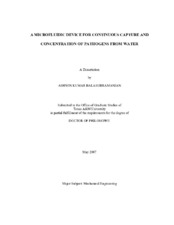| dc.description.abstract | A microfluidic device, based on electrophoretic transport and electrostatic trapping of charged particles, has been developed for continuous capture and concentration of microorganisms from water. A generic design, utilizing mobility and zeta potential measurements of various microorganisms exposed to different environmental conditions and physiological states, was employed. Water and buffer samples at pH values ranging from 5.2–7.0 were seeded with bacteria (E. coli, Salmonella, and Pseudomonas) and viruses (MS-2 and Echovirus). Negative control and capture experiments were performed simultaneously using two identical devices. Both culture based methods and real-time PCR analysis were utilized to characterize the capture efficiency as a function of time, flowrate, and applied electric field. Based on differences between the capture and negative control data, capture efficiencies of 90% to 99% are reported for E. coli, Salmonella, Pseudomonas, and MS-2, while the capture efficiency for Echovirus was around 75%. Overall, the device exhibits 16.67 fold sample volume reduction within an hour at 6 mL/hr. This results in a concentration factor of 15 at 90% capture efficiency. Direct quantification of capture on the anode of the prototype microfluidic device was also performed by particle tracking using fluorescent microscopy. Based on image processing, the capture data at different locations on the electrode surface is quantified as a function of the wall shear stress at these locations, which is calculated using CFD simulations. Finally, the Faradaic processes in the microchannel due to electrochemical reactions are studied to predict the amount of electrophoresis in the system. Scaling of the device to sample 5 L/hr can be achieved by stacking 835 identical microchannels. Power and wetted volume for the prototype and scaled devices are presented. The device can thus function either as a filtration unit or as a sample concentrator to enable the application of real-time detection sensor technologies. The ability to continuously sample water without chemical additives facilitates the use of this device in drinking water distribution systems. This work constitutes the first step in our development of a continuous, microbial capture and concentration system from large volumes of potable water. | en |


